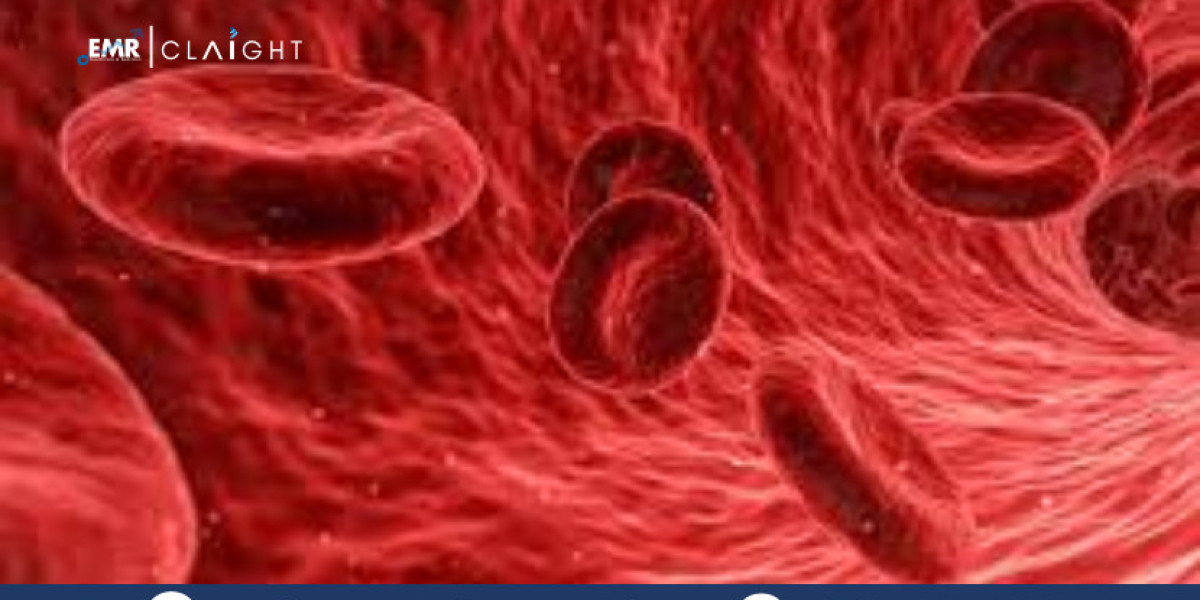Bleeding Disorders Therapeutics Market Overview
The global bleeding disorders therapeutics market has gained considerable momentum over the past few years, propelled by advancements in biotechnology and increasing awareness of genetic and acquired bleeding disorders. These conditions, including hemophilia A, hemophilia B, von Willebrand disease, and liver-induced coagulopathies, impair the body’s ability to form blood clots, leading to prolonged bleeding episodes. Treatment typically involves the replacement or enhancement of clotting factors, either through plasma-derived or recombinant products.
As the burden of bleeding disorders continues to rise worldwide, particularly among genetically predisposed populations and patients undergoing liver dysfunction, the demand for efficient, targeted, and long-lasting therapeutics has intensified. Ongoing research, growing government support, and strategic collaborations among leading biopharma companies are shaping the future of this dynamic market.
Bleeding Disorders Therapeutics Market Size and Share
The bleeding disorders therapeutics market size is projected to grow at a CAGR of 7.4% during 2025–2034. Although precise valuation figures vary by source, the market is expected to reach significant multi-billion-dollar figures by the end of the forecast period. North America currently dominates the market owing to robust healthcare infrastructure, while Europe follows closely. However, Asia Pacific is gradually catching up due to growing investments in healthcare and increasing awareness campaigns.
Key revenue contributions come from recombinant coagulation factor concentrates, particularly for the treatment of hemophilia A and B. With an increasing number of clinical trials and new drug launches, the market share of advanced therapeutics is expected to rise significantly over the coming years.
Bleeding Disorders Therapeutics Market Trends
Shift Towards Recombinant Therapies Over Plasma-Derived Products
A major trend in the market is the growing preference for recombinant coagulation factor concentrates over plasma-derived counterparts. Recombinant therapies reduce the risk of viral transmission and offer more consistent therapeutic effects. Advances in genetic engineering and cell line development have enabled the production of more stable, longer-acting clotting factors, making them a more convenient and safer option for patients with severe hemophilia.
Gene Therapy as a Promising Long-Term Solution
Gene therapy is emerging as a potential one-time treatment for hemophilia and other inherited bleeding disorders. By introducing functional genes into a patient’s cells, this approach can offer long-lasting or even permanent correction of clotting factor deficiencies. Several clinical trials have demonstrated promising results, and the regulatory pipeline includes gene therapy candidates that could transform the treatment landscape in the coming decade.
Increasing Focus on Prophylactic Treatment Regimens
Traditionally, bleeding disorders have been managed through on-demand treatments. However, there is a growing shift toward prophylactic (preventive) therapy, particularly for patients with severe forms of hemophilia. Prophylaxis helps prevent spontaneous bleeding episodes and joint damage, significantly improving patients' quality of life. This change in clinical practice is driving demand for long-acting coagulation factor products and improved drug delivery systems.
Technological Advancements in Diagnostic and Monitoring Tools
Innovations in diagnostic technologies and wearable devices are enabling real-time monitoring of clotting factor levels and bleeding events. These tools support personalized treatment regimens, ensuring patients receive optimal dosing while minimizing adverse effects. Advanced diagnostics also help in early detection and monitoring of inhibitor development, which is a common complication in hemophilia treatment.
Bleeding Disorders Therapeutics Market – Essential Insights Inside! Dive into detailed trends, projections, and challenges. Get the report – no cost, no hassle!
Bleeding Disorders Therapeutics Market Analysis
Disease-Specific Therapeutics Gaining Prominence
The availability of therapies tailored to specific bleeding disorders like hemophilia A, B, and von Willebrand disease is improving treatment outcomes. Drug developers are focusing on creating targeted therapies with fewer side effects and longer half-lives.
Strong R&D Pipeline and Innovation-Driven Market
Biopharma companies are heavily investing in R&D to develop novel drugs, including monoclonal antibodies and gene editing platforms. Clinical trials for gene therapy and extended half-life factors are expanding rapidly.
Rising Global Healthcare Spending and Access
Developing economies are increasing their healthcare budgets, which is improving access to bleeding disorder diagnostics and therapeutics. Partnerships with NGOs and international health organizations are accelerating access to treatment in underserved regions.
Regulatory Support and Fast-Track Approvals
Many national and international regulatory bodies are granting orphan drug designations and priority reviews for bleeding disorder therapies, encouraging innovation and quick commercialization of promising candidates.
Bleeding Disorders Therapeutics Scope of the Report
This comprehensive report covers the historical trends, current dynamics, and future forecasts of the bleeding disorders therapeutics market from 2025 to 2034. It delves into growth drivers, market challenges, segment analysis, and regional performance.
Historical and Forecast Market Analysis by Segment:
Breakup by Disease Type:
- Hemophilia A
- Hemophilia B
- Von Willebrand Disease
- Liver Disease
- Others
Breakup by Drug Class:
- Plasma Derived Coagulation Factor Concentrates
- Recombinant Coagulation Factor Concentrates
- Others
Bleeding Disorders Therapeutics Regional Insights
North America and Europe
North America, particularly the United States, leads the bleeding disorders therapeutics market, driven by early adoption of advanced biologics, strong regulatory frameworks, and well-funded healthcare systems. Canada also contributes significantly through supportive reimbursement policies and national hemophilia programs. In Europe, countries like Germany, France, and the UK are investing in gene therapies and digital health tools to manage bleeding disorders efficiently. Both regions are home to major pharmaceutical companies actively engaged in drug development and clinical trials.
Asia Pacific, Latin America, and Middle East & Africa
Asia Pacific presents a lucrative growth opportunity, especially in countries like China, India, and Japan, due to rising awareness and expanding healthcare access. Australia and ASEAN nations are also stepping up hemophilia diagnosis and treatment infrastructure. Latin America, led by Brazil and Mexico, is gradually increasing therapeutic penetration with support from public-private initiatives. In the Middle East & Africa, Saudi Arabia and the UAE are investing in biotechnology and rare disease treatment, though broader regional challenges in access and affordability remain.
Bleeding Disorders Therapeutics Market Growth
The market's growth trajectory is fueled by several factors: the rising incidence of bleeding disorders, growing awareness programs, increasing patient diagnosis rates, and technological advancements in drug formulations and delivery systems. The potential for one-time curative therapies through gene editing and RNA-based platforms presents a massive opportunity. Furthermore, expanding government initiatives and NGO support for affordable treatments in low-income regions will open new avenues for market expansion.
Recent Developments & Challenges
- FDA Approves Hemlibra for Expanded Hemophilia A Indication (2024) – Roche’s Hemlibra received approval for use in previously untreated patients, broadening its market reach and supporting early intervention strategies.
- Sanofi Announces Positive Phase 3 Results for efanesoctocog alfa (2024) – A novel, long-acting factor VIII replacement therapy demonstrated improved bleeding control and reduced infusion frequency in hemophilia A patients.
- CSL Behring Launches New Plasma-Derived Factor IX in Europe (2024) – The product provides a stable and effective treatment for hemophilia B, with fewer side effects and longer action duration.
- WHO and WFH Launch Global Initiative for Hemophilia Treatment Access (2024) – The initiative aims to improve diagnosis, treatment access, and healthcare infrastructure in low- and middle-income countries.
Challenges in the market include high treatment costs, development of inhibitors in patients, limited access in underdeveloped regions, and the need for lifelong therapy. Addressing affordability and manufacturing scalability will be critical to overcoming these barriers.
Bleeding Disorders Therapeutics Key Players
CSL Behring
CSL Behring is a global leader in plasma-derived and recombinant therapies for bleeding disorders. Its portfolio includes innovative products like Idelvion and Afstyla. With significant investments in research and global manufacturing, CSL continues to expand its therapeutic reach, especially in hemophilia A and B treatment segments.
Bayer AG
Bayer has a long-standing presence in the bleeding disorders market with key products such as Kogenate and Jivi. The company focuses on next-generation therapies and has an active gene therapy program in collaboration with various biotech firms. Bayer's robust distribution network ensures global access to its therapeutic solutions.
Novo Nordisk A/S
Novo Nordisk is a key player in recombinant coagulation factors, offering products like NovoSeven and Esperoct. The company is investing in long-acting therapies and personalized treatment solutions. Its strong presence in Europe and expanding reach in Asia Pacific make it a formidable competitor in this sector.
Biogen Inc.
Biogen, through its spin-off company Bioverativ (now part of Sanofi), developed Eloctate and Alprolix, pioneering extended half-life coagulation factor therapies. The company remains at the forefront of innovation in hemophilia care and collaborates extensively in gene therapy research for bleeding disorders.
Other Key Companies Include:
Sanofi SA, Octapharma AG, Grifols S.A., Pfizer Inc., Baxter International Inc., and Takeda Pharmaceutical Company.
FAQs
Q1. What is the bleeding disorders therapeutics market growth rate?
The global bleeding disorders therapeutics market is expected to grow at a CAGR of 7.4% during the forecast period 2025–2034.
Q2. Which regions lead the global bleeding disorders therapeutics market?
North America and Europe are the dominant markets due to strong healthcare infrastructure and high awareness. Asia Pacific is projected to experience the fastest growth.
Q3. What are the main types of bleeding disorders?
Key disorders include hemophilia A, hemophilia B, von Willebrand disease, and bleeding caused by liver dysfunction.
Q4. What are the major drug classes used for treatment?
The main drug classes include plasma-derived coagulation factor concentrates, recombinant factor concentrates, and emerging gene therapies.
Q5. What are the challenges faced in this market?
High treatment costs, inhibitor development, limited healthcare access in low-income countries, and the need for lifelong treatment remain key challenges.
Find More Reports
About Us:
Expert Market Research is a leading market research firm delivering data-driven insights to the pharmaceutical, biotechnology, and medical device industries. Our comprehensive research solutions include market research reports, providing in-depth analysis of industry trends and competitive landscapes; drug pipeline reports, tracking drug development progress, clinical trials, and regulatory approvals; epidemiology reports, offering detailed disease prevalence and patient population studies; and patent reports, assessing intellectual property landscapes and innovation trends, among others.
Leveraging proprietary data, advanced analytics, and expert methodologies, we help businesses navigate complex markets, optimize strategies, and drive innovation. We empower clients with actionable intelligence, enabling them to make informed decisions and stay ahead in the rapidly evolving healthcare sector.
Media Contact:
Company Name: Claight Corporation
Contact Person: Roshan Kumar, Digital Marketing
Email: sales@expertmarketresearch.com
Toll-Free Number: US +1-415-325-5166 | UK +44-702-402-5790
Address: 30 North Gould Street, Sheridan, WY 82801, USA
Website: www.expertmarketresearch.com






